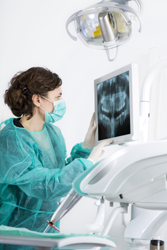Teeth reveal bone density status
The EC-funded OSTEODENT project was set up to investigate the suitability of dental radiography as a diagnostic tool for osteoporosis. Dental radiography is likely to provide as much information regarding bone density as traditional monitoring methods. The project had aimed to recruit a total of 600 women at various stages of the menopause in order to test the hypothesis. In trying to achieve the project's aims, project partner University of Manchester generated a database comprising mandibular cortical width data obtained from dental panoramic radiographs. The data from 661 volunteers aged 45 to 70 were obtained using newly developed software. Out of the group, 140 women were classified as having osteoporosis. The results indicated that dental radiography can be an effective diagnostic tool for osteoporosis and its use could indeed signal a breakthrough in osteoporosis diagnosis. Further research is warranted in order to determine the appropriate diagnostic threshold in a clinical setting. Researchers also believe that the dataset may be potentially useful in the field of dental implants, allowing insights into bone quality through cortical thickness data. Overall, the innovative approach which this dataset represents could pave the way into further developments in this area.



